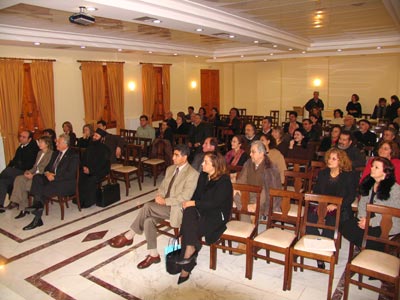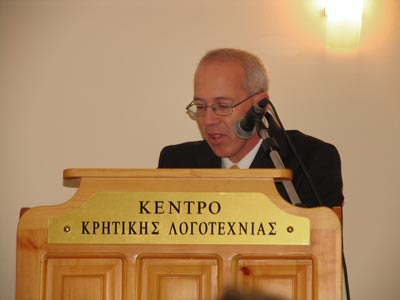The Cretan Literature Centre was founded in 1997 as a joint initiative by “Nikos Kazantzakis” Municipality, the University of Crete and the Society of Literati of Crete. The Centre is situated next to the Kazantzakis Museum and has a membership of 90, most of whom are scholars and artists. Its basic aim is to support the Museum and promote its work. The Centre is also, however, engaged in an ambitious attempt to record, study and promote Cretan literature. To date, it has organised successful literary events and tributes to important scholars. It has also organised international conferences in collaboration with “Nikos Kazantzakis” Municipality and other official bodies, and published important works of Cretan literature

On 22 January the members of the Cretan Literature centre cut their New Year’s cake in an unpretentious ceremony. This included a fascinating lecture by Gareth Owens, Ph.D., on the subject of “The Minoan language: scripts and languages of Minoan and Mycenaean Crete”.
Dr Gareth Owens was born in Britain in 1964. He studied History and Classics at University College, London, followed by an MA in Greek Literature and History, and also Philosophy. He has lived in Crete for the past 18 years, for the last 12 of which he has worked at the TEI of Crete. During this period he completed an important linguistic study of the Minoan language, which formed the subject of his doctoral dissertation at the University of Athens. It should be noted that his lecture on the Minoan language presented at Varvari, of which a summary is given below, is based on his 10-year research into the language of Minos’s Crete. During this time, Dr Owens studied thousands of published and unpublished inscriptions from Minoan Crete.

The language of the Minoans
The language of the Minoans is held to be that expressed in the Linear A script. Linear B, which was deciphered by Michael Ventris in 1952, is considered to record the so-called Mycenaean tongue, the precursor of Ancient Greek.
Here we must also mention the existence of a third, undeciphered, script, Cretan Hieroglyphic. An example of Cretan Hieroglyphic, undeciphered to date, is the famous clay Phaistos Disk, with its spiral writing nowadays believed to run from the circumference to the centre.
According to Dr Owens, the difference of phonetic patterns between Linear A and B is only about 10%; in other words, the two scripts are about 90% similar. This permits us to give a limited reading of Linear A, but not understand it. It also gives us valuable information on the origin and characteristics of the language.
Beginning our research with inscriptions in Linear A carved on offering tables found in the many peak sanctuaries on the mountains of Crete, we recognise a clear relationship between Linear A and Sanskrit, the ancient language of India. There is also a connection to Hittite and Armenian. This relationship allows us to place the Minoan language among the so-called Indo-European languages, a vast family that includes modern Greek and the Latin of Ancient Rome.
The Minoan and Greek languages are considered to be different branches of Indo-European. The Minoans probably moved from Anatolia to the island of Crete about 10,000 years ago. There were similar population movements to Greece. The relative isolation of the population which settled in Crete resulted in the development of its own language, Minoan, which is considered different to Mycenaean. In the Minoan language (Linear A), there are no purely Greek words, as is the case in Mycenaean Linear B; it contains only words also found in Greek, Sanskrit and Latin, i.e. sharing the same Indo-European origin.
The above conclusions are based on Dr Owens’s study of 50 Minoan words in Linear A, of the total of about 600 words recorded to date. Research continues and dozens of researchers hope that, one day, the Minoan language will reveal all its secrets. This will allow us a better understanding of that great civilisation, the civilisation of the Keftiu, as the Ancient Egyptians called our Minoan ancestors, perhaps due to their skill with the bow.
https://en.wikipedia.org/wiki/Gareth_Alun_Owens
That’s crazy, Brizzo! I had a dream about a lifetime in Minoan Crete too! It’s actually going to find it’s way into a book I’m writing so was doing a little more research. I live on the north Oregon coast.
I seem to recall a prior lifetime in Minoan Crete, several thousand years ago. We lived on a long street in a suburb of one of the Minoan cities. We were in a row house, with small gardens planted about it. Our family looked like the people in archaeological text illustrations. A number of the people I knew back then, I know to day in Portland, Oregon where I live. If it were possible to locate Minoan People, do age-regressions under hypnosis, and go back to their past lives as Minoans, it might be possible to retrieve data on the unknown Linear A written Script and the Minoan language. I also, recall a past life on Sicily in c.410 BC, during the wars between Athens and Dionysius. Reincarnation past lifetime study would seem a good means to obtain presently unknown data on the Minoan culture.